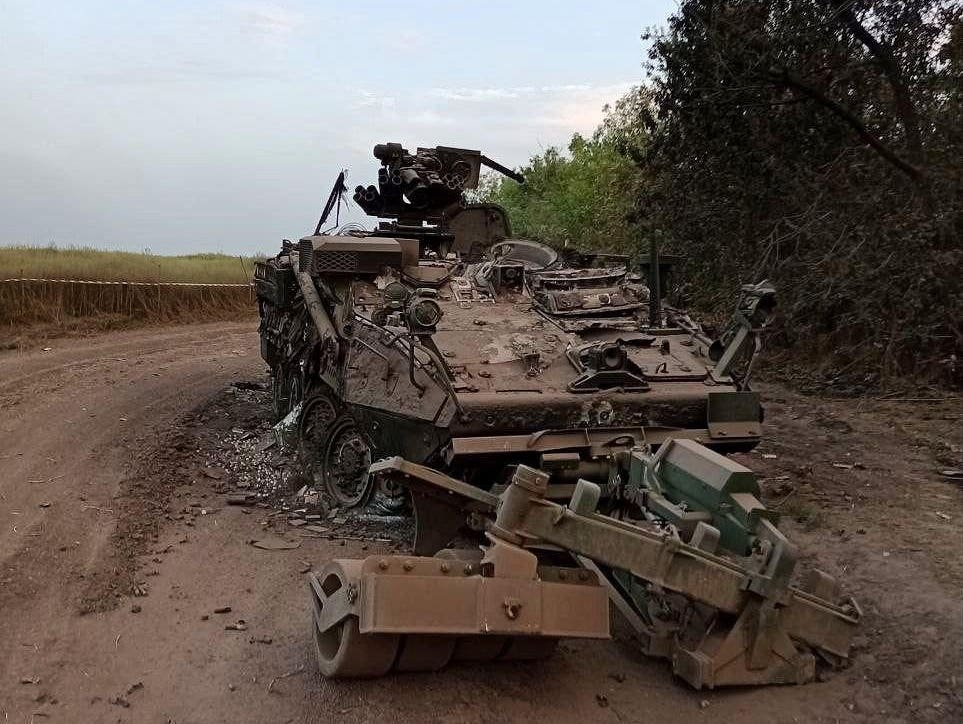The Ukrainian air assault force’s 82nd Air Assault Brigade sat out the first nine weeks of Ukraine’s 2023 counteroffensive, which kicked off along several axes in southern and eastern Ukraine on June 4.
When the powerful brigade finally rolled into action with some of its 14 British-made Challenger 2 tanks, 40 ex-German Marder tracked infantry fighting vehicles and 90 Stryker wheeled IFVs, it immediately began losing vehicles.
This week, the 82nd wrote off at least two of its 20 or so M1132 Engineer Squad Vehicles—mineclearing versions of its 18-ton, eight-wheel Stryker infantry-carriers. The M1132 features a set of hull-mounted minerollers that can detonate buried mines before the vehicle triggers them.
It’s unclear what struck the M1132s and whether the crews survived. It’s possible the vehicle were victims of the same mines their crews were trying to clear. It’s also possible they got caught in artillery barrages or were hunted down by drones. In any event, the 82nd already has lost 10 percent of its mineclearing Strykers.
It was fairly obvious why Ukrainian commanders held back the 2,000-person 82nd Brigade. When the brigades leading the assault needed to pull back for rest and reset, the 82nd would be available to take their place.
That moment came last week, when elements of the 82nd shifted into action around Robotyne, a key Russian strongpoint on the axis running through Tokmak to Melitopol, 50 miles from the front line in occupied southern Ukraine.
The lead unit for the Robotyne assault, the Ukrainian army’s 47th Mechanized Brigade, by then had lost at least 25 of its 99 American-made M-2 tracked infantry fighting vehicles. The 82nd Brigade apparently joined the fight in order to bolster the flagging 47th.
It should come as no surprise that the two M1132s are the 82nd’s first confirmed losses. The brigade likely is sending M1132s ahead of its main assault columns in order to clear lanes through Russian minefields around Robotyne. With safe paths through the mines, the 82nd’s Strykers, Marders and Challenger 2s can push deeper into Robotyne, or bypass and cut off the city’s Russian garrison.
It’s vital but dangerous work, especially for the two crew and up to nine sappers who ride in the lightly-armored M1132. Most military mineclearing vehicles are built on heavy, thickly-armored tank hulls—but not the M1132. U.S. firm General Dynamics Land Systems designed the Strkyer to be transportable by air. In other words, light.
That makes it vulnerable to mine blasts, artillery fragments, anti-tank missiles and even heavy machine guns. The same lightness also means the addition of a two-ton set of minerollers significantly burdens an M1132, especially cross-country.
The M1132’s lightness compelled U.S. Army commanders to devise creative ways of deploying the vehicle. In the spring of 2004, Army captain Robert Thornton recalled his time leading a Stryker company, including attached M1132s, in realistic war games.
The Engineer Squad Vehicle’s mine-rollers “greatly impact ESV mobility,” Thornton wrote in Armor, the Army’s official tank journal. Weighed down as they attempted to complete a breach through enemy defenses, the sappers were easy targets.
There was just one way to keep the engineers alive and safeguard the mineclearing operation—and that was to target a spot along the fortified front line with minimal enemy manning. “When we set conditions for breaching out of contact, the sappers lived,” Thornton wrote.
That’s easier said than done, of course. It’s hard to stage scores of armored vehicles and hundreds of troops without the enemy noticing and shifting forces to meet the attackers.
The alternative to sneaking forward is to push the defenders away from their berms, trenches and bunkers just long enough for the sappers to do their explosive work.
The U.S. military might accomplish that by bombing the enemy line from the air just ahead of a breaching attempt. The Ukrainians with their meager air force don’t really have that option. An accurate and intensive artillery barrage might suppress enemy troops long enough for the M1132s to clear a minefield. But Ukraine’s artillery batteries are busy targeting Russia’s artillery batteries.
All that is to say, the 82nd Brigade probably is clearing minefields around Robotyne while under fire. And for the brigade’s lightweight engineering vehicles, that’s extremely dangerous.
Here’s the good news. The United States has pledged 189 Strykers to Ukraine’s war effort—more than enough to replace the 82nd’s losses and equip additional brigades. And if those 189 Strykers run out, no problem: the U.S. Army has hundreds more Strykers in storage.
Read the full article here





